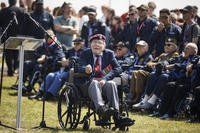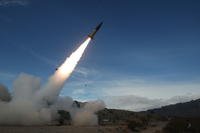Here's a novel observation from Sandra Erwin of National Defense magazine: These days, even the Army's basic-transportation Humvees, MRAPs and other vehicles -- hardly exemplars of passenger comfort, and delivered without chilled champagne refrigerators -- can cost more than a Bentley. Not only that, the Army could pay $180,000 to upgrade a single Humvee for which it originally paid $50,000. Multiply that times 60,000 vehicles and you could be talking about some real money.
The brass is in a bind: Should it assume the Army's vehicles of tomorrow will need to protect soldiers against the same kinds of improvised explosive devices that have taken such an awful toll in Iraq and Afghanistan? If so, that means bulkier, heavier vehicles with more protection -- and bigger price tags.
Not able to predict what IEDs future enemies may use against U.S. forces, vehicle buyers face tough tradeoff decisions among weight, cost and protection, RAND analysts noted. And no matter what protection is acquired, there is no guarantee it will work. “Technology-based solutions to mitigate vulnerability are expensive, whereas the enemy’s countermeasures are relatively cheap,” the study said. Both the Army and Marine Corps have been weighing whether to fix or buy new as they map out their future truck fleets, but it appears increasingly likely that they will do more fixing than buying.The truck that is being designed to replace the Humvee -- the Joint Light Tactical Vehicle -- is coming in at higher than expected costs. The original estimate for JLTV was approximately $250,000 per vehicle. The latest number from the Army is $300,000 per vehicle, and some outside estimates have exceeded $400,000, according to RAND. The large investment planned to refurbish the current Humvee fleet suggest that the military may be scaling back future JLTV purchases and expects to keep the Humvee going for a couple more decades.
As always, there's a political element at work here, too. The Army watched carefully as the Marines fought to save their beloved Expeditionary Fighting Vehicle -- and lost. One key reason for congressional skepticism on the EFV was that its design pre-dated the IED era, and it wasn't equipped with updated protection against roadside bombs for when it finished swimming ashore and drove up on to the beach. This made the Marines exasperated. First they explained that they would never use the EFV anyplace where the bad guys had time to set up IEDs, then they said they would add a bolt-on armor kit that an EFV's crew could use if they'd be spending a lot of time driving around as a normal armored personnel carrier. Pretty thin, skeptics concluded.
The lesson for the Army is that it daren't try to field new or upgraded vehicles without IED and crew protections. That means part of the decision has already been made here, and even tomorrow's "light" utility vehicles may be heavier than ever, and with price tags to match.








